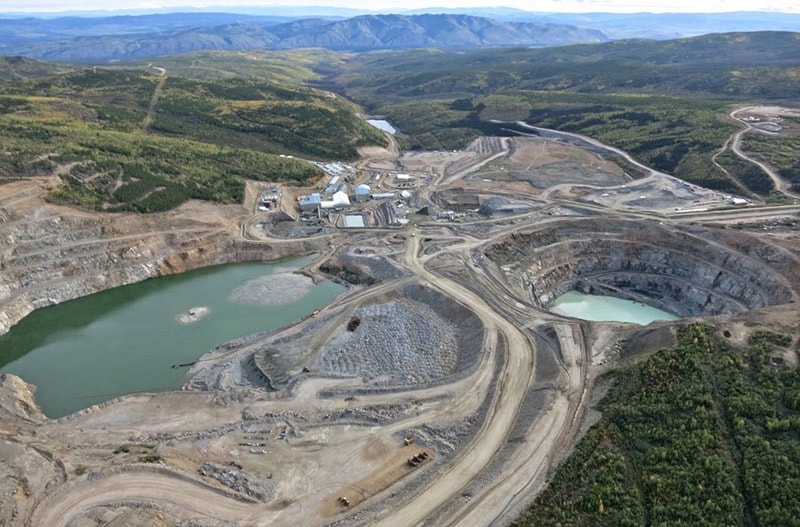The new water plan for the famously leaky Minto mine is full of holes, says Environment Canada.
A proposal to funnel storm water off the site doesn’t make sense because data is missing and different sections conflict with each other, says Environment Canada’s response to the plan, filed with the Yukon Environmental and Socioeconomic Assessment Board last week.
Parts of the plan are “unsettling” and resemble a “corporate approach to managing water at the site,” wrote Benoit Godin, head of assessment and contaminants at Environment Canada’s Yukon office.
The mine, owned by Vancouver-based Capstone Mining, has been heavily criticized for its less than stellar approach to water management.
Last year, it applied for emergency water discharges three times. The mine dumped more than 1 million cubic metres of excess partially treated water into the Yukon River between July and September last year.
The Yukon Water Board slammed Capstone for abusing the emergency provisions in its water licence but granted the discharges anyway.
The mine kept flooding because Minto’s water-management plan was badly drawn up, said Capstone president Stephen Quinn, at the time.
A new water-management plan would address the problems, he said last August.
Now, the plan seems a dud.
Minto is proposing a system of waterways that would keep storm water and tainted water separated.
But some sections state storm water won’t be diverted from the system, writes Godin.
The catchment system for storm water is also faulty. The models treat each catchment as having the same inclination, while in reality some are slanted in different directions, causing water to flow differently than what’s expected.
The mine repeatedly lowballs how much water is flowing into the water-storage pond, and the final amount can’t be accounted for, writes Godin.
The mine also presented conflicting estimates on the size of the site. In the current plan, the roads, plant site and tailing stacks are jotted in at 32 hectares. But in a 2007 filing, the Minto mine described the tailings as being 37.3 hectares.
The mine used summer evaporation rates to calculate how much rainwater would stay in the water storage pond. It should have used real data from the last few years, says the document.
And tables on water spillage don’t include data from summer 2009, a very wet year in Minto’s books.
But perhaps the biggest disagreement between Minto and Environment Canada is on how to discharge water back into the environment.
Capstone’s plan focuses on diluting water that leaves the site. That means it can discharge dirtier water with more chemicals inside it, as long as it dilutes it with the right amount of water.
Environment Canada thinks that’s cost-saving on the back of the environment. It’s better to lower the contamination by treating the water before it leaves the site.
Capstone’s dilution method doesn’t account for the cumulative impact of minesite water on the Yukon River, says Environment Canada.
The discharge might be clean with respect to its water-to-chemical ratio, but it still means more chemicals being dumped in the river overall.
Quinn, Capstone’s president, was aware of Environment Canada’s submission on its water-management plan, but he hadn’t read it yet.
He defends his company’s dilution method.
Water in the Yukon River could be more polluted or less polluted than what the mine spews out, so the discharge should be dilution-based to better adjust to the conditions, he said.
“If you’ve got a river running and you add a teaspoon of water, is it relevant?” he said. “It’s that versus putting a hose pipe into a small creek - obviously it has a completely different impact.”
Quinn didn’t respond to Environment Canada’s criticism that the plan doesn’t address cumulative impacts, but said the disagreement is part of the regulatory process.
“The whole point of the process is that the regulators sit down and decide if they agree or disagree,” said Quinn.
“Now it’s up the intervenors to make their submission and the regulators to make their decision,” he said.
The Yukon Environmental and Socioeconomic Assessment Board doesn’t ask a proponent to reply to every question an intervenor has. It only questions the proponent on whatever points it feels are valid.
The water plan also includes upgrades to the mine’s overall production.
Capstone is applying to dump more water, crush more rock and sell more copper ore than before.
“It’s because the mine is currently able to outperform its designed specs,” said Quinn. “Holding it back doesn’t make much sense.”
The mill has performed well in the last few years and should be able to handle an increased workload, he said.
“You’re not adding any pieces of equipment,” said Quinn. “You’re just running that equipment a little harder.”
The mill will require “modestly more” electrical power, he said.
The proposal is undergoing public comments until February 3.
Contact James Munson at
jamesm@yukon-news.com
